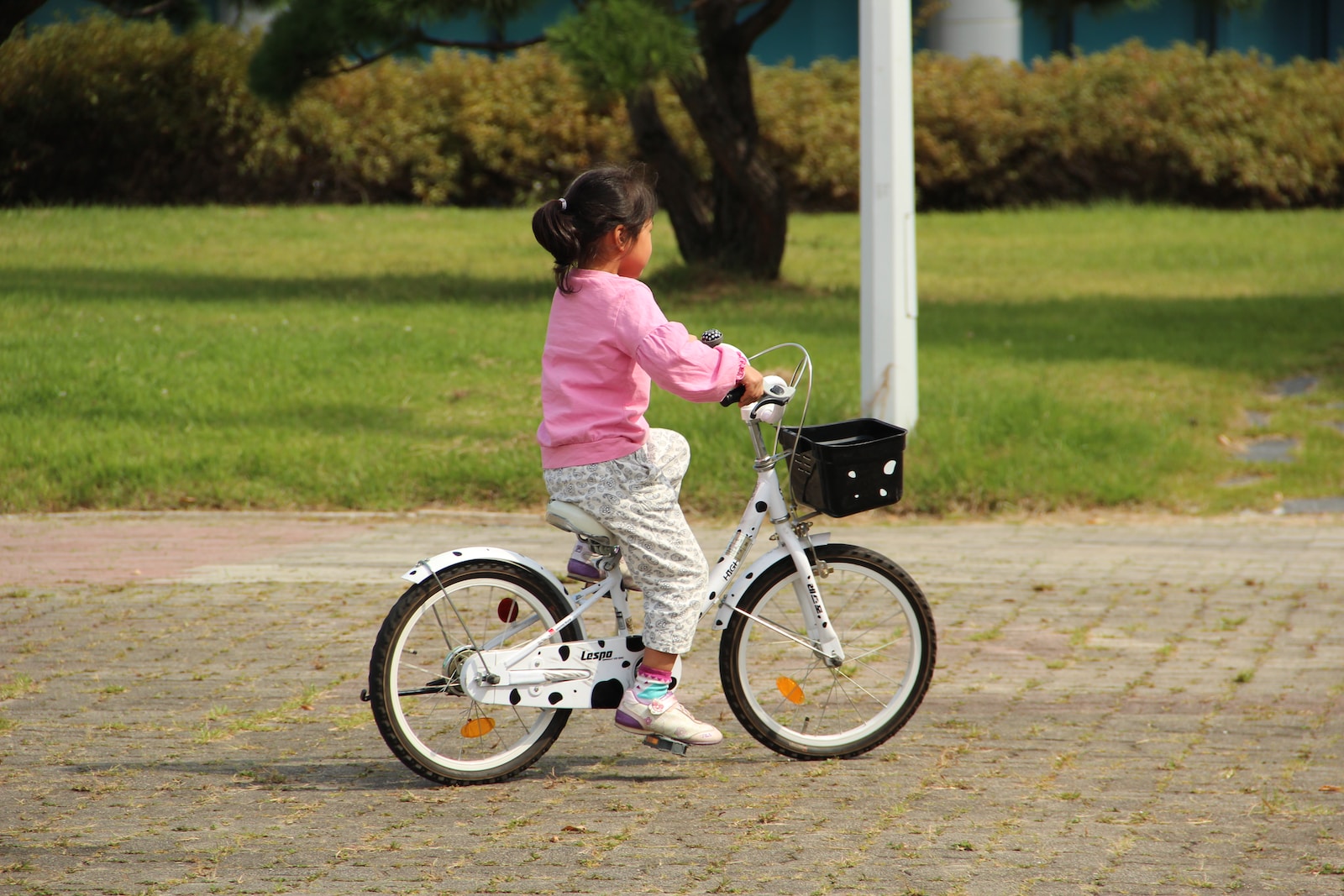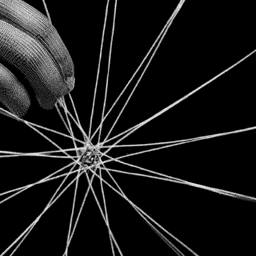Are you prepared to start a thrilling adventure with your child in the cycling world? Before you start riding, it’s important to select the correct bike size for your little one. It’s essential to find the right fit to improve their comfort, enjoyment, and safety.
In this guide, I’ll share essential tips and techniques to accurately measure bicycle size for kids. Get ready to dive into the technical aspects of bike sizing, age and height guidelines, and much more.
Let’s pedal into the world of precision and safety!
Key Takeaways
- Head circumference should be measured to determine proper helmet sizing and fit
- Consider weight, durability, and ride quality when choosing a bike frame material
- Wheel size determines the overall stability and maneuverability of the bike
- Balance bikes eliminate the need for training wheels and promote coordination and confidence.
Importance of Choosing the Right Bicycle Size
Choosing the right bicycle size for kids is important because it ensures their safety and comfort while riding. When choosing the appropriate bike size for a child, it is crucial to consider their height, leg length, and age.
If a bike is too big or too small, it can have a significant impact on their comfort and safety. A bike that is too big may be difficult for a child to control, causing them to lose balance or struggle to reach the pedals. On the other hand, a bike that is too small can result in cramped leg space, leading to discomfort and potential injuries.
Understanding the importance of selecting the correct bike size will help provide a safe and enjoyable riding experience for kids.
Now, let’s dive into understanding the different bike types for kids.
Understanding the Different Bike Types for Kids
When it comes to bikes for your little ones, you’ll want to know the different types available.
There are several different bike brands that specialize in making bikes for kids, such as Strider, Schwinn, and WOOM. Each brand offers a variety of models designed for different ages and skill levels.
The benefits of biking for kids are numerous, including improved cardiovascular health, increased coordination, and the development of a lifelong love for physical activity.
It’s important to choose a bike that is appropriate for your child’s age and size, as this will ensure their safety and comfort while riding.
In the next section, we will discuss age and height guidelines for bike sizing, which will further help you determine the right bike for your child.
Age and Height Guidelines for Bike Sizing
To determine the appropriate bike for your child, you’ll want to consider their age and height. Age guidelines can provide a general starting point, but it’s important to also take into account your child’s height. This will ensure a comfortable and safe riding experience. Below is a table that outlines age and height guidelines for bike sizing:
| Age Range | Height Range |
|---|---|
| 2-4 years | 2’10” – 3’4″ |
| 4-6 years | 3’1″ – 3’7″ |
| 6-9 years | 3’7″ – 4’2″ |
Keep in mind that these are just guidelines and every child is different. It’s always best to have your child physically try out different bike sizes to find the one that fits them properly. Once you have determined the appropriate size based on age and height, the next step is measuring inseam length for accurate sizing. This will ensure the bike’s seat height is adjusted correctly for your child’s comfort and safety.
Measuring Inseam Length for Accurate Sizing
Once you’ve determined the appropriate age and height range for your child, it’s important to accurately measure their inseam length for a properly adjusted bicycle seat. The inseam measurement is crucial because it determines the ideal seat height, allowing your child to properly reach the pedals and maintain control of the bike.
To ensure accurate sizing, follow these steps:
- Stand your child against a wall with their feet shoulder-width apart.
- Place a book between their legs, pressing it firmly against their groin.
- Measure from the top of the book to the floor, using a tape measure or ruler.
- Record the measurement in inches or centimeters.
By taking the inseam measurement, you can select a bike with the appropriate seat height for your child. This will provide them with a comfortable and safe riding experience.
Moving forward, let’s discuss considerations for adjustable and growing bikes.
Considerations for Adjustable and Growing Bikes
Adjustable and growing bikes are designed to accommodate children as they continue to grow and develop. These bikes offer various adjustable features that allow for a customized fit as your child grows taller and gains more confidence in their riding abilities. One of the key benefits of these bikes is that they provide a longer lifespan since they can adapt to meet your child’s changing needs.
To give you a better understanding of the advantages of adjustable and growing bikes, let’s take a look at the following table:
| Adjustable Bike Features | Benefits of Growing Bikes |
|---|---|
| Adjustable seat height | Ensures proper leg extension for efficient pedaling and comfort |
| Extendable frame | Provides a longer reach as your child grows for better posture |
| Adjustable handlebars | Allows for a comfortable and ergonomic riding position |
These features not only enhance the riding experience but also promote proper body mechanics and reduce the risk of strain or injury.
Now that we understand the benefits of adjustable and growing bikes, let’s move on to testing the bike’s fit and comfort.
Testing the Bike’s Fit and Comfort
When considering adjustable and growing bikes for kids, it’s important to think about the bike’s fit and comfort. But how do you know if the bike is the right size for your child? That’s where a bike fit assessment comes in. By evaluating your child’s riding posture, you can determine if the bike is the correct size and if any adjustments need to be made.
Here are four key aspects to consider during the assessment:
- Saddle height: Ensure that your child’s feet can touch the ground while seated, but not fully extended.
- Handlebar position: The handlebars should be at a comfortable height and distance from the saddle, allowing for proper arm and hand placement.
- Knee alignment: Check that your child’s knees align directly over the pedals when riding.
- Reach: Your child should be able to comfortably reach the handlebars without straining or overreaching.
By assessing these factors, you can ensure that your child’s bike provides a safe and comfortable riding experience.
Now, let’s discuss some important safety precautions for child bike riders.
Safety Precautions for Child Bike Riders
To ensure your child’s safety while riding a bike, it is important to follow these safety precautions.
First and foremost, make sure your child has the necessary bike riding skills before allowing them to ride independently. They should know how to balance, steer, and brake effectively.
Additionally, it is crucial to choose the right bike accessories for your child. A properly fitted helmet is essential to protect their head in case of a fall. Knee and elbow pads can also provide extra protection. Reflectors and lights should be installed on the bike to enhance visibility, especially when riding in low-light conditions.
Lastly, teach your child about the importance of obeying traffic rules and being aware of their surroundings.
By following these precautions, you can ensure your child’s safety while riding.
Now, let’s move on to the next section about tips for adjusting the bike seat and handlebars.
Tips for Adjusting Bike Seat and Handlebars
Make sure you adjust your bike seat and handlebars properly for a comfortable and safe riding experience. When it comes to adjusting your bike pedals, it’s important to find the right position that allows for efficient pedaling and prevents any discomfort or strain on your knees.
You can start by positioning the pedals so that they are parallel to the ground when your feet are at the 3 and 9 o’clock positions. Additionally, ensure that the bike saddle is at the correct height. Your legs should have a slight bend at the knees when the pedal is at its lowest point. Finding the right bike saddle is crucial for comfort and preventing any potential injuries. It should be wide enough to support your sit bones and have adequate padding.
Moving on to the next section about proper helmet sizing and fit, it’s essential to protect your head while riding.
Proper Helmet Sizing and Fit
Ensure your helmet fits snugly and securely on your head to provide maximum protection while cycling. Helmet safety is crucial, and proper sizing and fit are essential for optimal protection.
To determine the correct helmet size, measure the circumference of your child’s head just above the eyebrows with a flexible tape measure. Match this measurement to the helmet sizing chart provided by the manufacturer. Adjust the helmet’s straps and retention system to ensure a snug and secure fit. The helmet should sit level on your child’s head, covering the forehead and not tilting forward or backward.
Check for proper fit by shaking your head from side to side and up and down. The helmet should stay in place without sliding.
Now that we’ve covered helmet safety and size adjustment, let’s move on to choosing the right bike frame material for kids.
Choosing the Right Bike Frame Material for Kids
When selecting a bike frame material for your child, consider factors such as weight, durability, and ride quality. The right frame material can greatly affect your child’s biking experience.
Here’s a comparison of different bike frame materials and their pros and cons:
- Aluminum: Lightweight and affordable, aluminum frames provide a responsive ride. However, they may not offer as much comfort as other materials and can be prone to dents.
- Steel: Known for its durability, steel frames are sturdy and absorb road vibrations. They are also more forgiving in terms of impact. However, they tend to be heavier than other materials.
- Carbon fiber: Offering a lightweight and stiff frame, carbon fiber provides excellent power transfer and a smooth ride. However, it can be more expensive and less durable than other materials.
Understanding the impact of wheel size on ride is crucial for finding the right bike for your child.
Understanding Wheel Size and its Impact on Ride
Understanding the impact of wheel size on ride is crucial in choosing the right bike for your child. Wheel size selection plays a significant role in determining the overall stability and maneuverability of the bike.
Smaller wheels, such as 12-inch or 16-inch, are suitable for younger children as they provide better control and balance. These wheels also allow for easy maneuvering, making it simpler for kids to learn how to ride.
On the other hand, larger wheels, like 20-inch or 24-inch, are more suitable for older kids who have already developed their riding skills. These wheels offer greater stability and better performance, making them ideal for longer rides and varied terrains.
Understanding the impact of wheel size will help you make an informed decision when choosing the right bike for your child.
Moving on to recommendations for training wheels or balance bikes, it is important to consider their benefits as well.
Recommendations for Training Wheels or Balance Bikes
To choose between training wheels or balance bikes, you should consider the benefits they offer.
Training wheels are a common choice for parents who want their kids to learn how to ride a bike quickly. They provide stability and support, making it easier for children to balance. However, training wheels can create a false sense of security and hinder the development of balance skills.
On the other hand, balance bikes are a great alternative. They teach children how to balance from the start, allowing them to develop coordination and confidence. Balance bikes also eliminate the need for training wheels, making the transition to a regular bike smoother.
Overall, both options have their pros and cons, but balance bikes are often recommended for their ability to promote better balance skills.
Transitioning to the importance of regular bike maintenance for safety, it is essential to ensure that the bike is in good working condition to prevent accidents.
Importance of Regular Bike Maintenance for Safety
Make sure you regularly maintain your bike to ensure safety on the road. Regular bike maintenance is crucial for keeping your bike in optimal condition and preventing accidents.
Here is a checklist of common bike maintenance tasks that you should perform regularly:
- Clean your bike thoroughly to remove dirt and grime.
- Check and adjust your brakes to ensure they are working properly.
- Inspect your tires for any signs of wear and tear and inflate them to the correct pressure.
- Lubricate the moving parts of your bike, such as the chain and gears, to prevent rust and ensure smooth operation.
By following this regular bike maintenance checklist, you can avoid common bike maintenance mistakes and keep your bike safe and reliable.
Now, let’s discuss how to transition to a larger bike size as kids grow without compromising their safety.
Transitioning to a Larger Bike Size as Kids Grow
When your child outgrows their current bike, it’s important to smoothly transition them to a larger one while ensuring their safety. Bike size transition challenges can arise during this process, as kids need to adjust to the new dimensions and handle the increased weight. However, there are several benefits of providing them with a properly sized bike. Firstly, it promotes better control and maneuverability, reducing the risk of accidents. Secondly, it allows for a more comfortable riding experience, preventing strain and discomfort. Lastly, a bike that fits well enhances the child’s confidence and encourages them to explore new terrains. To help you understand the importance of sizing, take a look at the table below:
| Challenge | Benefit |
|---|---|
| Adjusting to new dimensions | Better control |
| Handling increased weight | Comfortable riding |
| Building confidence | Exploring new terrains |
Now that you know the benefits, let’s explore where to buy the perfect size bike for kids.
Where to Buy the Perfect Size Bike for Kids
If you’re looking for the perfect bike for your child, you can find it at various retailers both online and in-store.
When it comes to buying options, there are pros and cons to consider for both online and local stores.
Online shopping offers convenience and a wide range of options, allowing you to compare prices and read reviews from other customers. However, you won’t be able to test ride the bike before purchasing, and returns can be a hassle.
On the other hand, local stores allow you to physically see and try out the bikes, ensuring a proper fit for your child. Additionally, store staff can provide expert advice and assistance. However, the selection may be limited, and prices might be higher compared to online retailers.
Ultimately, it’s important to weigh these factors and choose the buying option that suits your needs and preferences.
Frequently Asked Questions
Are there any safety precautions specific to child bike riders that parents should be aware of?
Parents must prioritize helmet usage for child bike riders to ensure their safety. It is crucial to teach kids proper signaling and road safety skills to avoid accidents. These precautions are essential for a child’s well-being while riding a bike.
How do I properly adjust the bike seat and handlebars for my child’s comfort?
To ensure proper bike fit, it’s crucial to regularly adjust the seat and handlebars for your child’s comfort. This not only enhances their riding experience but also promotes better control and reduces the risk of injuries.
What are the guidelines for choosing the right bike frame material for kids?
When choosing the right bike frame material for kids, it’s important to consider bike frame durability. Different materials, such as steel, aluminum, and carbon fiber, have their own pros and cons in terms of strength, weight, and cost.
How does wheel size impact the ride of a bicycle and what should parents consider when selecting the appropriate wheel size for their child?
When selecting a bicycle for a child, the wheel size is crucial. A study found that children who ride bicycles with properly sized wheels have better balance and control. Factors to consider include the child’s height, age, and riding experience.
Where can I find the perfect size bike for my child?
I can help you find the perfect size bike for your child. When looking for the best brands, consider factors like their age, height, and riding experience. Prices can range from affordable options to higher-end models.
Conclusion
In conclusion, choosing the right bicycle size for kids is crucial for their safety and comfort while riding.
By understanding the different bike types, age and height guidelines, and measuring inseam length accurately, parents can ensure that their child’s bike fits them perfectly.
Regular bike maintenance is also important to ensure safety on the road.
As kids grow, it’s important to transition to a larger bike size to accommodate their changing needs.
Remember, finding the perfect size bike is like finding a needle in a haystack – it may take some time and effort, but it’s worth it for a smooth and enjoyable ride.
















